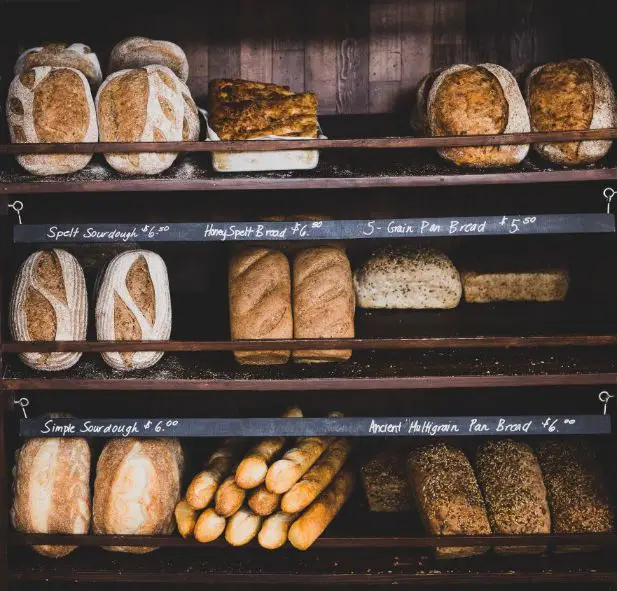Baking your own bread is a rewarding experience, but what if you want to reduce your sugar intake or have dietary restrictions that require you to cut out sugar?
Can you make bread without sugar? The answer is a resounding yes!
In this article, I’ll reveal if you can make bread without sugar and which bread variates are sugar-free.
Additionally, I’ll discuss the pros and cons of adding sugar to your bread recipes, providing insight into its effects on the bread’s flavor, texture, and nutritional composition. Let’s dive in.
Can You Make Bread Without Sugar – Revealed
Absolutely, you can make bread without sugar. Sugar is often used in bread recipes to feed the yeast and add a touch of sweetness to the flavor, but it’s not a strict requirement for making bread.
When making bread without sugar, you can still achieve a delicious and satisfying loaf.
The yeast can feed on the natural sugars present in the flour, and you can enhance the flavor of your bread with ingredients like olive oil, honey, or molasses if you want a hint of sweetness without using granulated sugar.
Which bread is sugar-free? Top 5
Many types of bread are naturally sugar-free, especially basic bread made from flour, water, yeast, and salt.
Here are some common sugar-free bread:
1. Whole Wheat Bread
When baking traditional whole-wheat bread, remember to stick to the basics. You’ll need whole wheat flour, water, yeast, and salt. No added sugar is necessary.
This simplicity makes it a wholesome and sugar-free choice for your bread-making endeavors.
The absence of added sugar in whole wheat bread is a boon for those aiming to cut down on sugar intake. Plus, it’s packed with fiber and nutrients, making it a healthy staple in your diet.
For the best results, opt for high-quality whole wheat flour and allow your dough to rise and develop flavor for a richer, more robust bread.
2. Sourdough Bread
Sourdough bread is a marvel of natural fermentation. It rises without the need for added sugar, thanks to wild yeast and lactic acid bacteria.

Embrace the distinct tangy flavor and chewy texture that these microorganisms provide, all while keeping your bread naturally sugar-free.
In addition to being sugar-free, sourdough is often easier on the digestive system due to the fermentation process.
3. Multigrain Bread
If you’re a fan of multigrain bread and want to keep it sugar-free, pay close attention to your recipe.
Ensure that no added sugars sneak their way in. The essence of multigrain bread lies in the variety of grains and seeds like oats, flaxseeds, and sunflower seeds.
These ingredients offer an array of nutrients and textures.
But remember, always scrutinize the ingredient list when buying or making multigrain bread to guarantee that you’re not inadvertently introducing sugar into the mix.
4. Rye Bread
Rye bread, which includes delightful variations like pumpernickel, is naturally sugar-free when made with the basic ingredients.
Rye flour, water, yeast, and salt are the primary components, and these do not require sugar for the bread to rise.
While it’s known for its unique, earthy flavor and dense, hearty texture, rye bread is more than just a tasty option.
It is a nutritional powerhouse that supports digestive well-being and is brimming with essential vitamins and minerals, including B vitamins, iron, and magnesium.
5. Ezekiel Bread
Ezekiel bread is a smart choice for health-conscious bakers, as it’s inherently sugar-free.

What sets it apart is its use of sprouted grains and legumes, which elevate the bread’s nutritional profile and digestibility.
Key ingredients in Ezekiel bread often include sprouted wheat, barley, lentils, and spelt, with no added sugars in the mix.
The sprouting process not only increases the nutrient content but also makes the bread easier to digest.
So, keep things simple and wholesome, and enjoy a sugar-free, nutritious loaf with every slice of Ezekiel bread you bake.
Pros and Cons of Adding Sugar to Bread
Adding sugar to bread can have both pros and cons, depending on your taste preferences and dietary considerations.
Below are some of the pros and cons of adding sugar to bread. Take a closer look to help you decide whether you want to include sugar in your bread recipe or not.
Pros
Here are some pros of adding sugar to bread dough:
1. Enhanced Flavor
Sugar plays a crucial role in the flavor profile of bread by adding a subtle sweetness.
It contributes to a well-rounded taste that can be especially appealing to individuals with a preference for sweet or mildly sweet bread.
The sweetness introduced by sugar can counterbalance the potential bitterness or sourness of other ingredients in the dough, resulting in a more harmonious and enjoyable flavor.
2. Improved Browning
Sugar enhances the visual appeal of bread by promoting browning during the baking process.

The Maillard reaction, a complex chemical reaction that occurs when bread is exposed to heat, is facilitated by sugar.
The result is a beautiful golden-brown crust, which not only looks appetizing but also offers a pleasant contrast to the bread’s soft interior, making it visually enticing.
3. Tender Texture
Sugar contributes to a more tender and delicate crumb structure in bread. This leads to a lighter and softer texture, making the bread more palatable and easier to eat.
The sugar’s ability to retain moisture in the dough also helps prevent the bread from becoming dry or overly dense, ensuring a satisfying, pleasant texture.
4. Yeast Activation
Sugar serves as a source of food for yeast, the microorganisms responsible for fermentation in bread dough.
When yeast consumes sugar, it produces carbon dioxide gas and alcohol, leading to dough expansion.
This fermentation process results in improved rising and leavening of the bread, creating a lighter, well-structured loaf with evenly distributed air pockets.
In turn, this contributes to the overall quality of the bread.
5. Extended Freshness
Sugar has moisture-retaining properties, which means it can help preserve the bread’s moisture content even after baking.

This quality prolongs the freshness of the bread and its shelf life.
The reduced rate of moisture loss due to sugar can result in bread that remains soft and enjoyable for a more extended period, reducing the likelihood of it becoming stale or dry quickly.
Cons
Here are some cons of adding sugar to bread dough:
1. Increased Caloric Content
One significant downside of adding sugar to bread is that it significantly boosts its caloric content.
Sugar is calorie-dense, and as such, its inclusion in bread recipes can lead to an overall increase in the number of calories per serving.

This can pose a problem for individuals who are actively trying to manage or reduce their daily calorie intake, such as those on a weight loss program.
2. Health Concerns
Excessive sugar consumption has been associated with a range of health issues. These include obesity, diabetes, and tooth decay.
When sugar is added to bread, it can contribute to a higher daily sugar intake, particularly if individuals consume bread in substantial quantities.
Hence, this can increase the risk of these health problems. It’s important to be cautious and consume sugar-added bread in moderation to mitigate these concerns.
3. Altered Taste
The introduction of sugar to bread can significantly impact its flavor profile. The sweetness from the sugar can mask some of the natural and subtle flavors of the bread.
This alteration may not be welcomed by those who prefer a more savory or neutral taste in their bread.
It can detract from the traditional and wholesome bread experience, making it less appealing to some consumers.
4. Risk of Over-Fermentation
Sugar is often used in bread recipes to help activate the yeast, which is crucial for the rising of the dough.
However, too much sugar in bread recipes can have unintended consequences.
It can lead to over-fermentation, causing the bread to have an overly sweet or even alcoholic taste. Striking the right balance of sugar is important to avoid this pitfall.
5. Blood Sugar Impact
Consuming bread with added sugar can lead to a rapid spike in blood sugar levels.
This sudden increase can be problematic for individuals with diabetes or those who are trying to maintain stable blood sugar levels.
The sharp rise in blood sugar can disrupt their glycemic control and have adverse effects on their health.
It is imperative for such individuals to be mindful of their bread choices and opt for low-sugar or sugar-free alternatives.
Can You Make Bread Without Sugar – Conclusion
In conclusion, making bread without sugar is not only possible but offers a range of healthy and flavorful options for those looking to reduce their sugar intake.
Some popular sugar-free bread varieties include whole wheat, sourdough, multigrain, rye, and Ezekiel bread. These options provide a variety of flavors and textures without the need for added sugar.
When deciding whether to add sugar to your bread dough, it’s important to weigh the pros and cons.
Adding sugar can enhance the flavor, promote browning, create a tender texture, aid in yeast activation, and extend freshness.
On the flip side, it adds more calories, raises health issues, alters taste, poses a risk of over-fermentation, and impacts blood sugar levels.
Ultimately, the choice of whether to include sugar in your bread recipe depends on your preferences and dietary needs, and it’s essential to strike the right balance to achieve the desired outcome.
Frequently Asked Questions
What Can I Use Instead of Sugar in Bread?
You can substitute sugar in bread with various alternatives like honey, maple syrup, agave nectar, or artificial sweeteners.
These options can add sweetness and moisture to the dough without granulated sugar. Experiment with quantities to achieve your desired taste and texture.
Why Does Bread Have Sugar?
Sugar serves multiple purposes in bread-making. Firstly, it acts as food for yeast, aiding in fermentation and making the bread rise.
Secondly, sugar enhances the bread’s flavor by adding sweetness. Additionally, it helps in creating a tender crumb and a golden-brown crust due to caramelization during baking. In some cases, sugar also prolongs the bread’s shelf life by retaining moisture.

